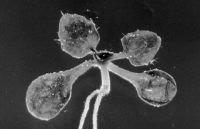More than 400 genes involved in the immune response of plants have been identified
2013/03/25 Lakar Iraizoz, Oihane - Elhuyar Zientzia Iturria: Elhuyar aldizkaria

The plants have identified 472 genes that can be detection receptors of microorganisms. These receptors are called immune target and it is they who initiate the protective response of plants. That is, they identify microorganisms and cause plants to react in one way or another, to be beneficial or harmful to plants. Then, they mediate on the complex exchange of signals between plants and microbes. The results have been published in the journal PLoS ONE.
So far, since the bases of plant immunity were established, only a few microbial receptors were found. In fact, plants have developed very sophisticated mechanisms to detect microorganisms in the area and, once detected, activate the immune system of protection or, if they are beneficial, allow its implantation in the rhizosphere.
The research was carried out using the model plant Arabidopsis thaliana. The main contribution of the study has been that the team has designed a new strategy to identify immune targets. “For identification we have followed the high-throughput strategy (high performance in English): we have used the microchip technology DNA, which uses the sequencing information of Arabidopsis, and the bacteriophage viruses, which allow the expression of all the possible proteins of this genome,” explains Susana García of the Department of Physiology of the UPV. “Thus, we have been able to analyze 20 million proteins, among which have been selected those that are able to interact with microorganisms. Thanks to this we have been able to know quickly the possible function of these 472 genes”.

Gai honi buruzko eduki gehiago
Elhuyarrek garatutako teknologia




